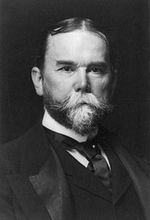- Nine-Power Treaty
-
The Nine-Power Treaty (九カ国条約 Kyūkakoku Jōyaku) or Nine Power Agreement(Chinese:九國公約) was a treaty affirming the sovereignty and territorial integrity of China as per the Open Door Policy, signed by all of the attendees to the Washington Naval Conference on 6 February 1922.
United States Secretary of State John Hay had issued the "Open Door Notes" of September-November 1899, followed by a diplomatic circular in July 1900, asking that all of the major world powers with vested interests in China declare formally that they would maintain an ‘open door’ to allow all nations equal rights and equal access to the treaty ports within their spheres of influence in China. Fearing that the European powers and Japan were preparing to carve China up into colonies, Hay also added provisions that Chinese territorial and administrative integrity should be maintained.
Although no nation specifically affirmed Hay’s proposal, Hay announced that each of the powers had granted consent in principle and treaties made after 1900 make reference to the Open Door Policy. Nonetheless, competition between the various powers for special concessions within China for railroad rights, mining rights, loans, foreign trade ports, etc. continued unabated.
The United States was especially leery of Japanese designs on China after the Russo-Japanese War (1904-1905) and the Twenty-One Demands (1915) and repeatedly signed agreements with the Japanese government pledging to maintain a policy of equality in Manchuria and China. These agreements concluded with Lansing-Ishii Agreement in 1917, which was soon shown to be completely ineffective.
During the Washington Naval Conference of 1921-1922, the United States government again raised the Open Door Policy as an international issue, and had all of the attendees (United States, Japan, China, France, Great Britain, Italy, Belgium, Netherlands, and Portugal) sign a new treaty which intended to make the Open Door Policy international law.
However, the Nine-Power Treaty lacked any enforcement regulations, and when violated by Japan during its invasion of Manchuria in 1931 and creation of Manchukuo, the United States could do little more than issue protests and impose economic sanctions.
World War II effectively nullified the Nine-Power Treaty.
The Nine-Power Treaty was one of several treaties concluded at the Washington Naval Conference. Other major agreements included the Four-Power Treaty and the Five-Power Treaty.
References
- Baer, George (1996). One Hundred Years of Sea Power: The U. S. Navy, 1890-1990. Stanford University Press. ISBN 0804727945.
- Lamb, Margaret (2001). From Versailles To Pearl Harbor: The Origins of the Second World War in Europe and Asia. Palgrave Macmillan. ISBN 0333738403.
- Myer, Carl L (1936). Treaty relations between the United States and the far east: (with special reference to the four-power, five-power, and nine-power treaties). Library of Congress Legislative Reference Service. ASIN B0008D24WG.
External links
Categories:- Treaties of the United States
- 1922 in Japan
- Interwar treaties
- Treaties concluded in 1922
- Treaties of the Empire of Japan
Wikimedia Foundation. 2010.

